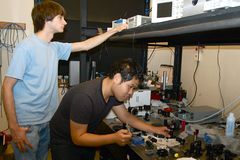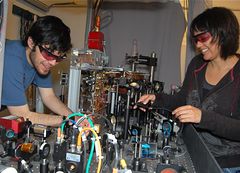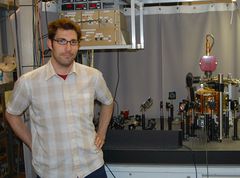Segrè Internship
Contents |
About the Emilio Segrè Internship
Since 1995, the Physics Department has offered a summer internship for Berkeley undergraduate and graduate students to learn research techniques as they work to improve the Physics 111 Advanced Lab and Basic Semiconductor Circuits course. Interns collaborate with faculty and staff for eight weeks in the summer to improve experiments and develop new ones. Their responsibilities include:
- researching the underlying physics of the experiments
- participating in building apparatus
- programming computers to acquire data and control experiments,
- testing and trouble-shooting experiments
Interns also provide valuable input by contributing to the write-ups for the experiments.
This program benefits both the student interns and all students who take the Physics 111 course. Interns learn in-depth about the experiments they work on, gain skills in building the apparatus and testing complex systems as they would in a research lab, and build confidence in their ability to do science. In the Physics 111 lab, virtually every experiment has been influenced by the hard work of these interns, who provide the perspective only a student can give on how to make an experiment understandable, meaningful, and feasible for students taking the course. The quality of this course absolutely depends on the participation of students in development of experiments.
The Physics Department gratefully acknowledges the generous gifts of Douglas C. Giancoli that have made this internship possible.
Honoring Emilio Segrè
This award is given in memory of Emilio Segrè (1905-1989). Born in 1905, Segrè was the first student to earn his doctoral degree under the sponsorship of Italian physicist Enrico Fermi, his friend and collaborator for more than three decades. Upon immigrating to this country in 1938 (he later became an U.S. citizen), Segrè accepted a position at the University of California, Berkeley. There, he commenced one of his most productive periods in nuclear physics, working with Glenn Seaborg, a chemistry professor, on methods of separating nuclear isomers. In the period following World War II, the anti-proton, an atomic particle that sought to prove nature’s symmetry still eluded scientists. In 1955, using Berkeley’s powerful new cyclotron, Owen Chamberlain and Emilio Segrè made the first observation of the anti-proton. This discovery signaled a major leap in the study of matter and anti-matter. Emilio G. Segrè received the Nobel Prize in 1959 for his work with Anti-Protons.
For a delightful biographical sketch of Emilio Segrè by UC Berkeley Professor J. David Jackson, see the National Academies Press site.
How to Apply for a Segrè Internship
Applications from current UC Physics undergraduate and graduate students are accepted in April of each year. Note: That this award WILL affect a recipient's financial aid. Please check with Claudia in (368 LeConte Hall) and the Financial Aid Office, 211 Sproul Hall, for more information. Your application should be submitted by the deadline of May 6th for the Summer of 2019, the Segre Internship will run from June 24th through August 19th (with one holiday for Independence Day). A stipend of $4,800 (possibly more depending upon available funding) is provided for the internship.
Planned projects for Summer 2019 include
- Trying out draft lab manual with new Nitrogen Vacancy Centers experiment developed for 111B
- Determining nominal NVC operating parameters, suggesting realistic scope for 9-day experiment, adding acrylic enclosures to limit adjustments thus keeping future students within realistic experiment scope
- Expanding data analysis options to include Python (as begun last year) and tools familiar in Data Science
- Programming the FPGA pulse-blaster (used for NV Centers) with serial I/O and MatLab interface, using Quartus Prime Lite software and MatLab
- Making a mini magnetometer for general display using Ensemble NV Centers
- Testing Windows 7 ability to reach fileserver and license server for LabVIEW, MatLab etc. via SheevaPlug or other hardware firewall and learning from colleagues’ experience at NanoLab, and/or testing a Windows 10 install in parallel
- Playing with flux pinning in liquid nitrogen cooled type II superconductors for educational demos in the lab
- Drafting design(s) to water-cut permanent magnet and/or electromagnet core for NV Centers and maglev
- Checking and fixing LabVIEW programs to work with new version of LabVIEW software
- Adding measured nominal operating values to diagrams of existing Advanced Lab experiments
- Responding to occasional 111A requests and knowing where to find their parts and tools
- Run the Beta Ray experiment with Cs-137 and baffle, upgrade source to meet learning objectives
- TBD
To apply for the Segrè Internship, print the flyer and application form 2019 application form , fill it out, and submit it to Winthrop Williams in the Physics 111 lab.
History of the Segrè Internship
Summer 2018 Interns
Shannon Baucom, Mike Lawrence, Matt Chow
Projects completed in 2018 include:
- Muon Lifetime Experiment noise reduction
- Pulsed NMR resonance drift measurement
- LabVIEW re-writes and upgrade to 2016
- Aiding in leadership transition (Don to Win)
- A new analysis package for BMC written in Python
- Production of introductory material for using Python
- Improvements to writeups including SHE, BMC, NMR, ATM, AFM, MUO, and more
- Experimentation with the 3D printer
- Testing lab equipment
- Video editing and production
Summer Interns 2017
Below in picture left to right:
Donald Orlando
Nicholas Werby
Rui Han
Jeffrey D. Molloy
Working on projects
Projects completed during Summer 2017 include
-
Testing of new software with old and new hardware for experiments
-
Make training videos for equipment and experiments.
-
Design, develop, & deploy the new 3D Printing experiment
-
Work on improving the advanced Lab write-ups making clearer on WEB site
-
Making & developing new interactive Pre-Lab questions.
-
Work on Beta Ray experiment to modify and get operational.
- TBD
Summer Interns 2016
Left to right below:
- Juan Pablo Castillo
- Daniel Naim
- Hunter Akins at AFM experiment
Don, Hunter, Daniel, and Juan at 3D Printer experiment
Hunter, Daniel, and Juan summer 2016 Segre group at QIE
Daniel doing tests on AFM viewing the results
Projects completed during the summer 2016 include
- 3D printing development
- Atomic Force Microscope developing more physics for the experiment, revising the Boltzmann Constant measurements , improving Noise floor measurements
- Developing questions in Storyline for the interactive Pre-Labs
- Worked on Hall Effect in a Plasma oscillations confusion in the units W.B. Kunkel article the best
- Adding check points to the experiment write-ups
- Correcting of some of the known write-up errors
- Developing new video for DS345 Function Generator
Summer Interns 2015
- Talya Sindel
- Eric Parsonnet
- Edward Zhang
Working on Magneto Optical re-alignment
Working on Optical Trapping camera issues and testing
Working on the New Atomic Force Microscope experiment
Adjusting the AFM-Atomic Force Microscope
Projects completed during the summer 2015 include
- Improve and change the Magneto Optical experiment; Mount, move, & re align optics to improve the experiment.
- Optical Laser Tweezers. Disassemble the whole complete Optical Trapping experiment and re-assemble it in the new location.
- Work on BSC breadboards redesign them and build new ones.
- Design, develop, & deploy the new Atomic Force Microscope experiment (AFM.)
- Work on improving the advanced Lab write-ups.
- Work on improving other parts of the 111-Lab as needed to make room for new experiments.
Summer Interns 2014
- Nathan Belmore
- Ryan Miller
|
Working on Magneto Optical Experiment new optical table and structure |
|
Working on the new Drupal web sites |
They worked on modifying many experiments in the 111-Lab during the summer renovations.
- Worked on the new Websites development of Instrumentation Lab and Experimentation Lab, code and content.
- Re-designed the Magneto Optical experiment adding a new structure and 4x8 air table for equipment, Installing new coil driver unit.
- Repaired code for Gamma, Brownian Motion, Optical Trapping, Atom Trapping, Muon Lifetime, Nuclear Resonance, Quantum Entanglement,
- Hall Effect in a Plasma -Zero field measurements
Summer Interns 2013
- Anthony Ransford
- Cliff Chen
- Sergiy Nesterenko
|
Anthony works on Magneto Optical Experiment |
|
Cliff Chen works on the NMR experiment. |
They worked on modifying many experiments in the 111-Lab during the summer renovations.
- Upgrading all LabView programs to LabView 2012
- Modifying of Gamma Ray, Muon Lifetime, Atomic Physics, NMR, Brownian Motion in Cells, Low Light Signals, Magneto Optical, Semiconductor Hall Effect, Non-Linear Dynamics, Rutherford, Quantum Interference and Entanglement, and Atom Trapping.
Summer Interns 2012
- Harry Nunns
- Nitin Ergert
- Griffin Hosseinzadeh
|
|
They worked on the Optical Trap, Instrumentation Lab experiments, and Quantum Interference and Entanglement.
Summer Interns 2011
Bennett Sodergren, , William Morong, and Guillermo Fong
|
Thanks to an increase in the annual donation from alumnus and author Douglas Giancoi (BA '60, PhD '66), the Department of Physics was able to offer three internships instead of the usual two.
Quantum Interference
The summer’s biggest project was a new experiment called Quantum Interference and Entanglement. The experiment is related to professor Häffner’s research in quantum computing (see page 4), and additional support for its development came from Häffner’s National Science Foundation Career Award and a donation from alumnus Hans Mark (BA ’51). The experiment creates entangled pairs of photons and demonstrates the phenomenon Einstein called “spooky action at a distance.” In the Advanced Lab, students will observe this effect and find that nature violates either the concept of locality or the principle that properties of objects might be ill-defined, such as in quantum mechanics. William Morong tested the single photon detectors, designed the power supply for them, developed software to handle the data and, with help from Bennett Sodergren, assembled the optical components.
Compton Scattering
Guillermo Fong led a substantial upgrade of the Compton Scattering Experiment, which had remained virtually unchanged since its creation 37 years ago. He tested a new Cd-Te X-ray detector that replaces the massive old Dewar-mounted detector with a single pocket-sized unit, and designed and fabricated a new apparatus that will allow students to test a variety of scattering targets. The new experiment gives students more options for creatively exploring the Compton effect and analyzing results at higher resolution.
Optical Tweezers
Bennett Sodergren began the summer by tearing apart the laser tweezers experiment, down to the bare breadboard. He rebuilt the microscope and beam path in a modular cage system that allows easier alignment and shields the beam without restricting access to the controls. He designed and assembled a second laser beam path to add capability for fluorescence microscopy. Students will use the new equipment to measure the stalling forces of single kinesin motor molecules, an experiment that comes from professor Yildiz’s biophysics research. Students will use the laser tweezers to maneuver a kinesin coated bead onto a fluorescent-labeled bundle of microtubules, then measure the force developed by the kinesin molecule as it pulls the bead along the microtubules.
Summer Interns 2010
Justin Ellin and Cassie Reuter
Undergraduates Cassie Reuter and Justin Ellin worked all summer to improve the lab’s new Atom Trapping experiment. During the experiment’s first year of use, students could not consistently achieve a reliable magneto optical trap (MOT). Justin and Cassie painstakingly analyzed the behavior of the system and devised a straightforward procedure that works. The new procedure requires students to generate absorption spectra for Rubidium (Rb) lines and derive an error signal based on the Rb spectra. Students then use this error signal to tune the two servo controllers to lock the laser frequency. With the clear, well illustrated instructions provided by Cassie and Justin, students are now able to reliably generate a MOT after a few days of hard work. Success is rewarded when the trapped atoms appear as a ball of bright fluorescence in the center of the vacuum chamber. Once this milestone is achieved, students can pursue other investigations that were previously out of reach. They can study the sensitivity of the MOT to changes in beam size and alignment, beam polarization, beam power balance, and magnetic field gradient. They can tie these results to the underlying atomic physics. By interrupting the laser beam for varying periods to observe the decay and loading of the trapped atoms, students can measure the number of atoms trapped and their temperature. So far, students have achieved temperatures as low as 100 milliKelvin, or one-tenth of a Kelvin. Besides working out new procedures, Cassie and Justin modified the apparatus and software to make the new investigations possible. They revised the beam path through the Dichroic Atomic Vapor Laser Lock (DAVLL), which allows measurement of the laser’s frequency, reassembled the vacuum apparatus, and realigned many of the optics. They wrote a new program in LabView to control and take data from the experiment, incorporating many new features that will benefit students.
Summer Interns 2009
Marjon Moulai, Andrew (Drew) Sheldon, and Adam Fries
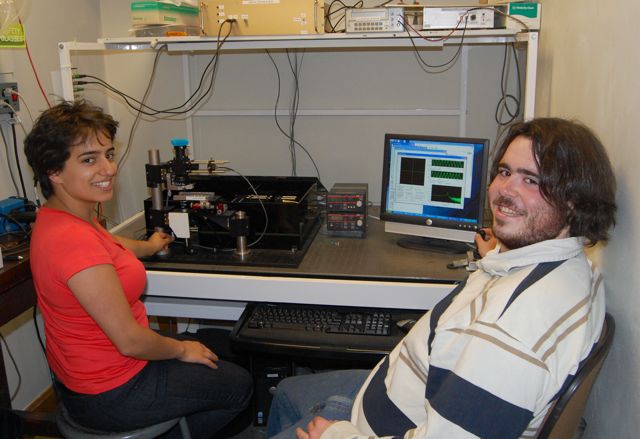 Marjon and Drew working on Optical Trapping
|
Among the tasks the 2009 group accomplished were upgrading the Muon Lifetime experiment with a second photo multiplier tube, testing and troubleshooting the optical trapping experiment, modifying and pilot testing lab software, completing an atom trapping experiment, and improving the Semiconductor Hall Effect experiment. The major milestone of the summer was achieving a viable atom trapping experiment. They added a set of permanent magnets to create a uniform magnetic field around the Dichroic Atomic Vapor Laser Lock (DAVLL). This involved modeling the magnetic field with Mathematica to optimize the spacing of magnets, machining aluminum magnet mounts on a mill, and aligning the laser beams through the DAVLL. They built a voltage divider to replace two amplifiers, which included modeling the circuit, prototyping it on a breadboard, and building the final unit by soldering components on a circuit board. Once the modifications were complete, Adam wrote a program in LabView to generate pulses and perturb the negative feedback control of the laser and developed procedures for students to use.
Summer Interns 2008
Tyler Draeger and Marjon Moulai
Development and testing of the Optical Trapping experiment, rebuilding Muon Lifetime Experiment to replace analog signal processing with all digital processing and analysis, upgrading Compton Experiment, testing and revising Brownian Motion in Cells experiment.
Summer Interns 2007
Diana Lee, Nicholas Ravn
Assembly and testing of magnet and cooling circuits for Atom Trapping experiment, relocation of Brownian Motion in Cells setup and setup of new Optical Trapping station, developing of new wiki for advanced lab writeups.
Summer Interns 2006
Hector Cota, Nathan Kamphuis
Building the infrastructure for the new atom trapping experiment, researching and testing Brownian Motion in Cells experiment, redesign of Josephson Effect experiment
Summer Interns 2005
Daniel Queens, Nathan Kamphuis
Summer Interns 2004
Winthrop Williams, Evan Wolf
Summer Interns 2003
Evan Wolf



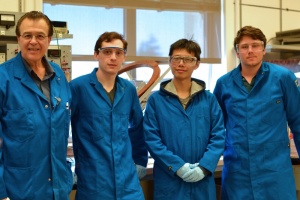

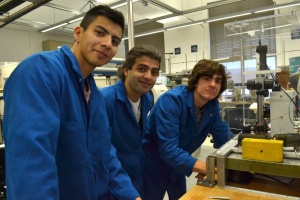
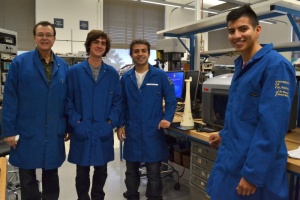
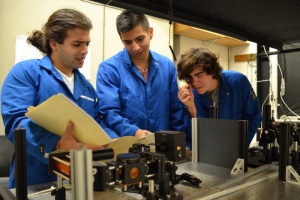
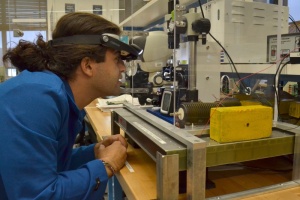

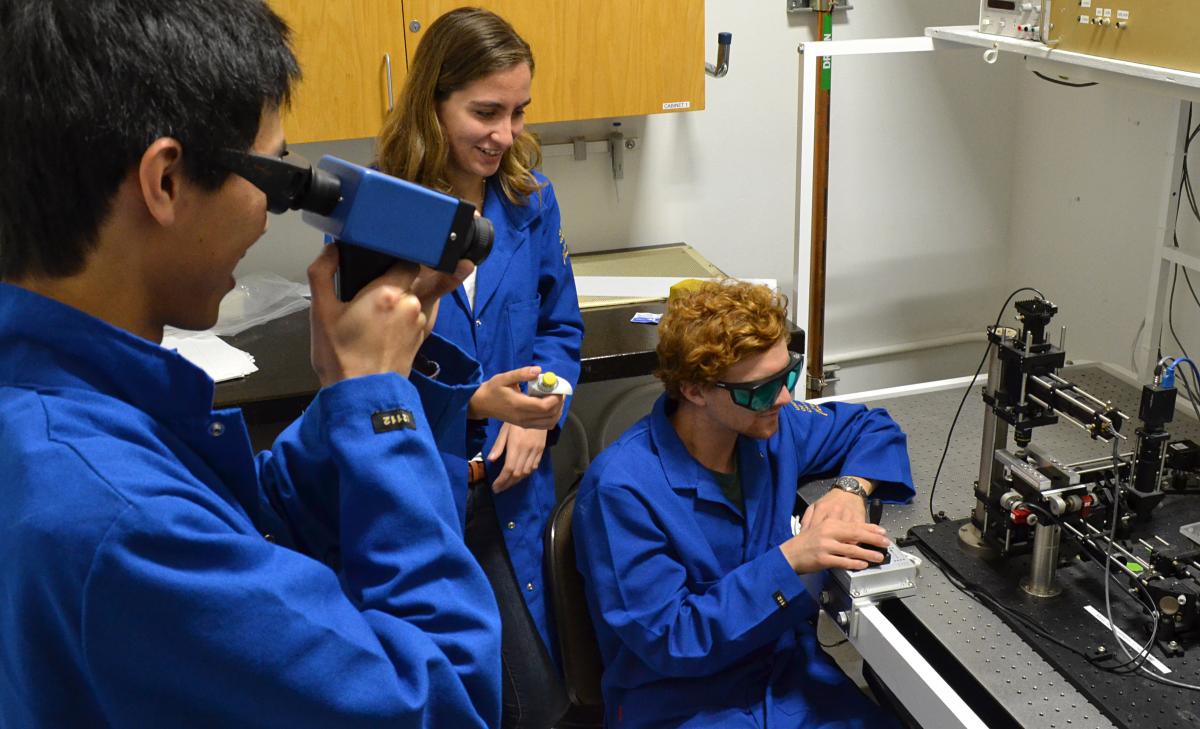
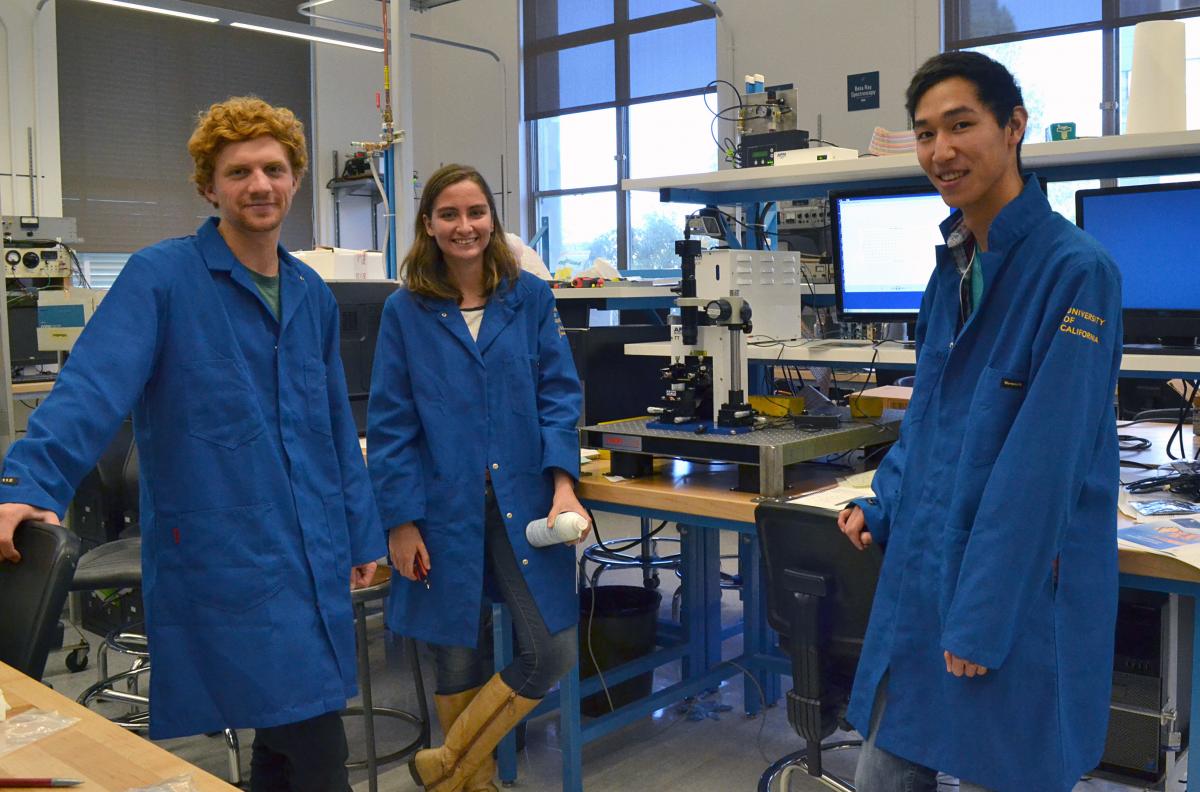

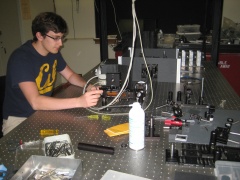

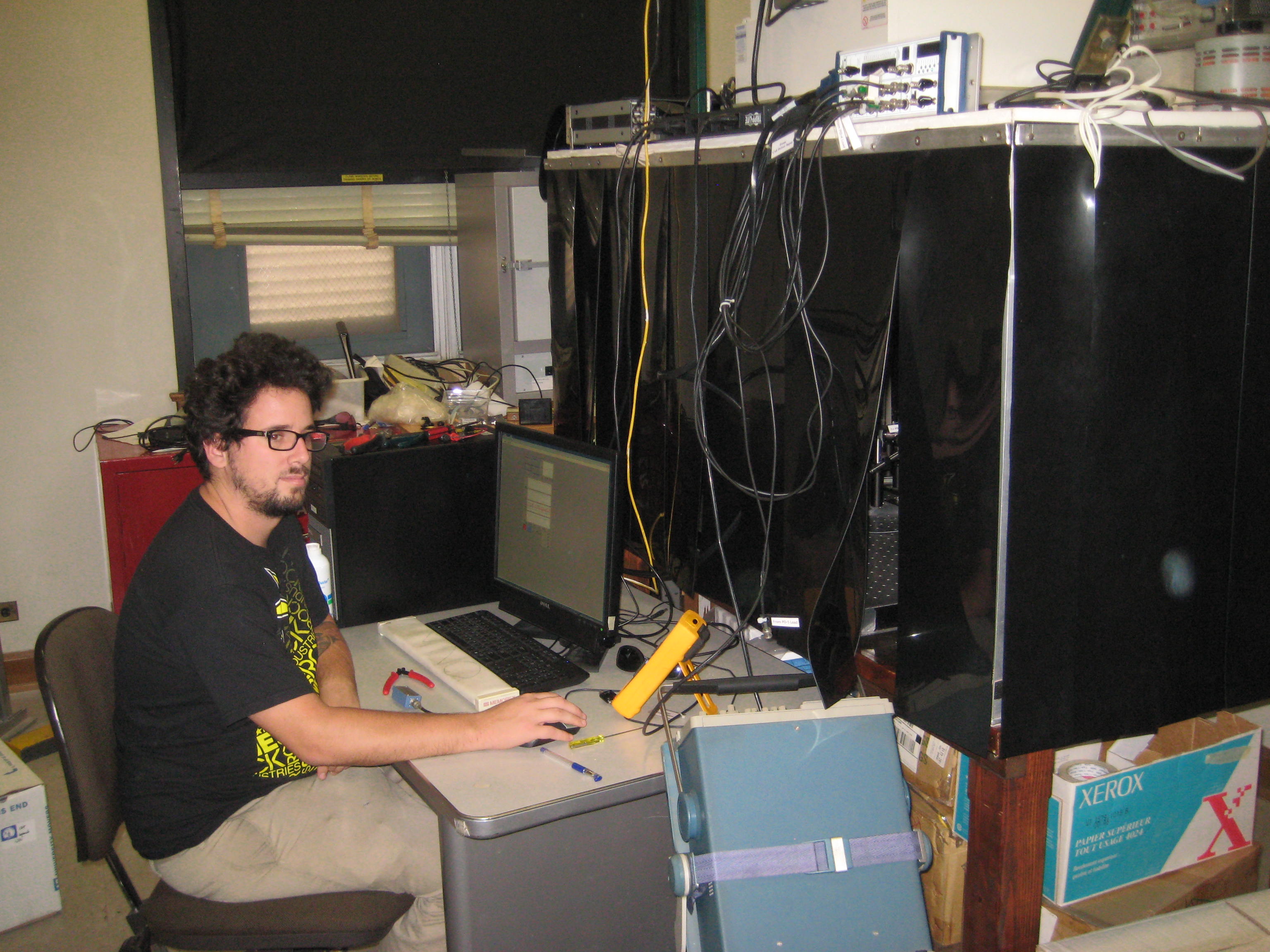
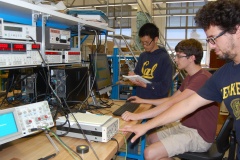
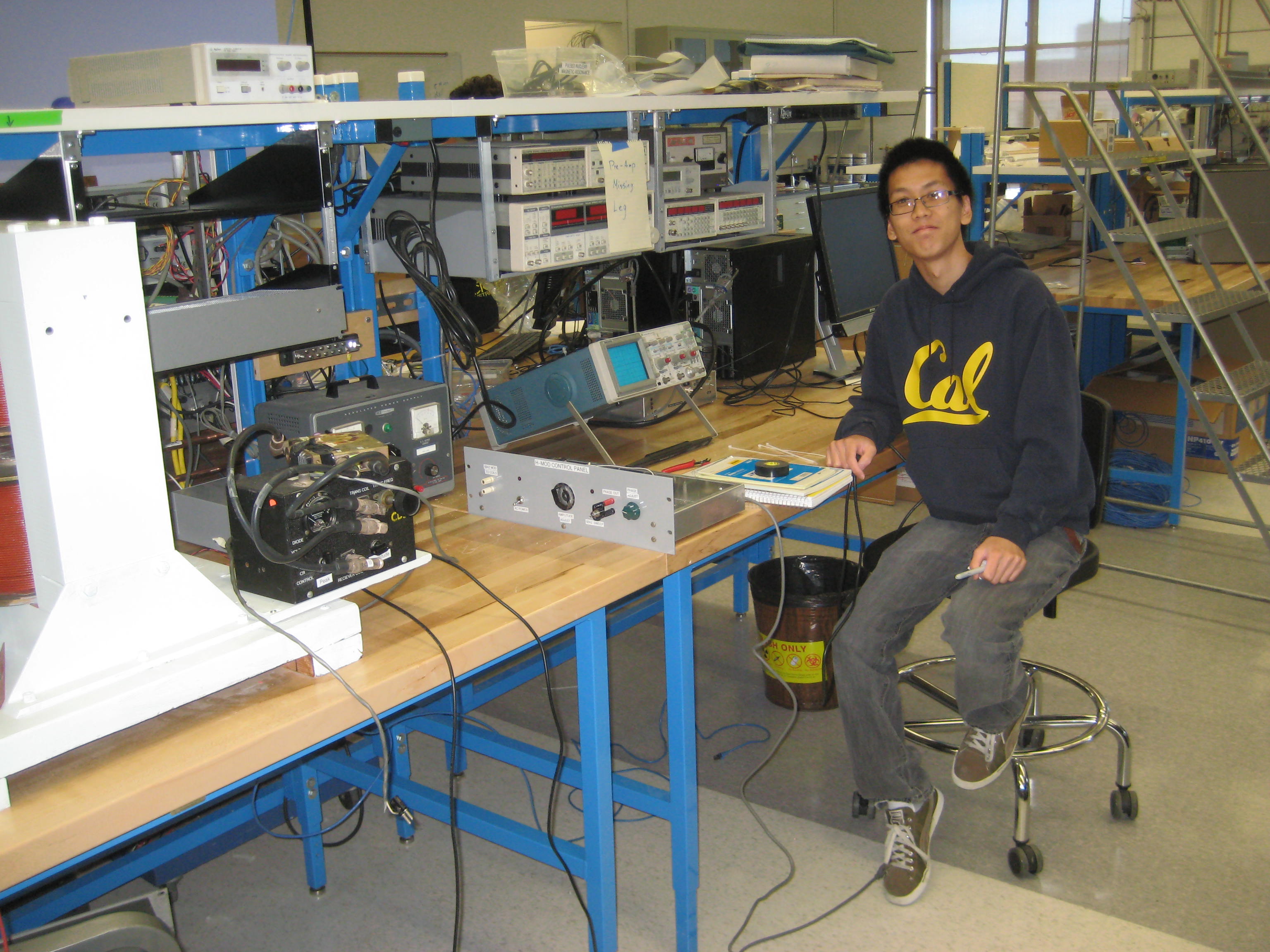
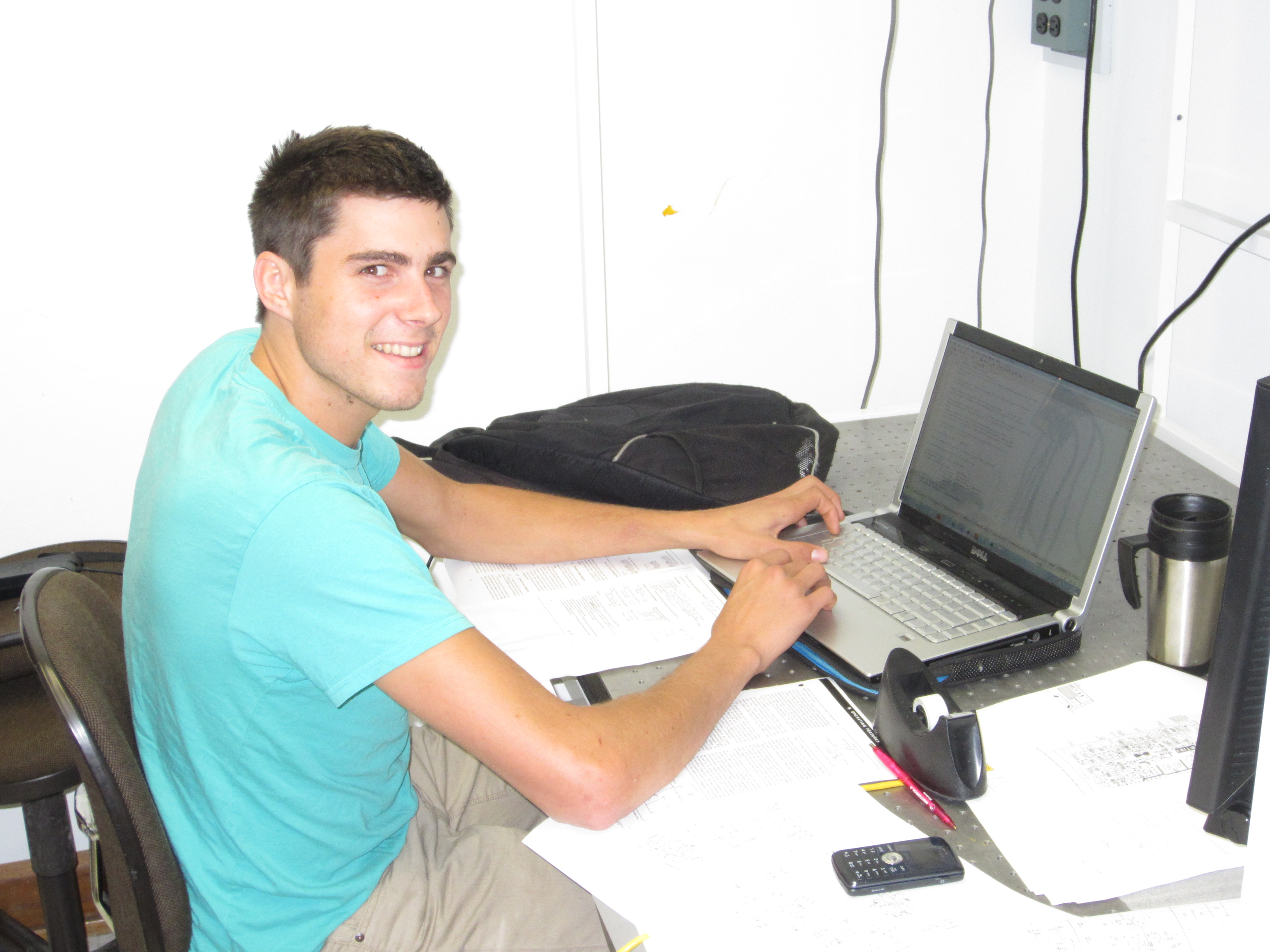
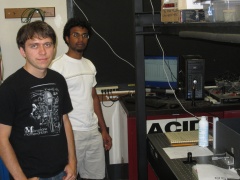
 Bennett Sodergren finishes rebuilding the optical trap
Bennett Sodergren finishes rebuilding the optical trap